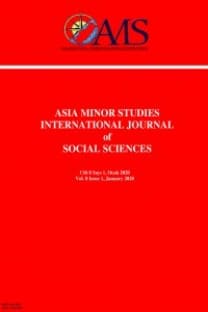Orhan Pamuk’un Beyaz Kale Adlı Eserine Yeni Tarihselci Bir Yaklaşım
Yeni Tarihselcilik, aynı tarihsel döneme ait edebi ve edebi olmayan metinlerin yorumlanmasına odaklanan modern bir eleştirel yaklaşımdır. Bir edebi eserin içinde bulunduğu dönemi yansıttığını göstermek için kendisini sınırlayan önceki tarihsel eleştirilerden farklı olarak, Yeni Tarihselcilik, eserin üretildiği dönemden nasıl etkilendiğini dikkate alır. On yedinci yüzyılda İstanbul'da geçen Beyaz Kale, bir Osmanlı bilim adamı ve Venedikli bir kölenin hikayelerini anlatan tarihi bir romandır. İlk bakışta, roman bu iki kişi arasındaki ilişkiyi anlatıyormuş gibi görünse de özenli bir irdeleme sonrasında, romanın aslında alternatif bir tarih sunduğunu görmekteyiz. Bu alternatif tarih, geleneksel tarihten çok farklıdır, örneğin, Sultan güçlü bir insan değil, zayıf yönleri olan bir kişidir. Örneğin paşalar ve Sultan, sahte bilime ve mantıksız rüya analizine sıkı sıkıya bağlıdır. Buna ek olarak, romanın kahramanı bir Sultan ya da saraydan bir kişi değildir. Bu bağlamda, romanın karakterlerinin geleneksel tarihsel romanlarda okumaya alışık olduğumuz karakterlerden çok farklı olduğu görülmektedir. Roman, hem anlatı teknikleri hem de karakterler açısından geleneksel tarihi romanlardan çok farklıdır.
A New Historicist Approach to Orhan Pamuk's White Castle
New Historicism is a modern critical approach focused on the interpretation of literary and non-literary texts which belong to same historical period. Unlike previous historical criticism which limits itself to basically showing how a literary work reflects its time, New Historicism takes into consideration how the work is affected by the time it was produced. Set in İstanbul in the seventeenth century The White Castle is a historical novel which tells the story of an Ottoman scientist and a Venetian slave. At first glance, the novel seems to describe the relationship between these two people, but a careful examination shows that the novel offers an alternative history. This alternative history is quite different from the usual history, for example, the Sultan is not a powerful person, but rather a person with weaknesses. For example, pashas and Sultan depend on the pseudoscience and illogical dream analysis. In addition, the protagonist in the novel is not a Sultan or a person from the palace. In this context, it seems that the characters of the novel are very different from the characters we are used to reading in traditional historical novels. The novel is quite different from the traditional historical novels in terms of both narrative techniques and the characters.
Keywords:
White Castle, New Historicism Alternative History,
___
- Berghahn, L., (1992). “New historicism: Editorial introduction.” Monatshefte, vol. 84, no. 2, pp. 141–147. JSTOR, www.jstor.org/stable/30161345.
- Haliloğlu, N., (2008). Re-thinking Ottoman Empire: East-West collaboration in Orhan Pamuk’s The White Castle. in Re-Thinking Europe Literature and (Trans) National Identity (pp. 111–122). New York: Rodopi.
- Jenkins, K., (2015). Rethinking history. London: Routledge.
- Murthy, N. J., (2014). Historicizing fiction/fictionalizing history representation in select novels of Umberto Eco and Orhan Pamuk. Newcastle upon Tyne, UK: Cambridge Scholars Publishing.
- Munslow, A., (2006). Deconstructing history. London: Routledge.
- Okur, N. A., (2009). Essays interpreting the writings of novelist 0rhan Pamuk. New York, Lewiston: Edwin Mellen Press.
- Pamuk, O., (2007). Other colours: Writings on life, art, books and cities. London: Faber.
- Pamuk, O., (2007). The White Castle. Jakarta: Serambi.
- Parla, J., (2009). Foreword. in Essays Interpreting the Writings of Novelist Orhan pamuk (pp. i-vii). New York, Lewiston: Edwin Mellen Press.
- Raw, L., (2013). The adaptation of history: Essays on ways of telling the past. Jefferson, NC: McFarland.
- White, H., (2005). Introduction: Historical fiction, fictional history, and historical reality. Rethinking History, 9(2-3), 147–157. doi: 10.1080/13642520500149061.
- ISSN: 2147-1673
- Yayın Aralığı: Yılda 2 Sayı
- Başlangıç: 2013
- Yayıncı: Serhat KUZUCU
Sayıdaki Diğer Makaleler
Kurtuluş Savaşında Kemalistlerin Malatya’daki Faaliyetleri
ABD’deki Çin Diasporasının Oluşumuna Giden Yol
Rus-Japon Savaşı Esnasında Karadeniz Gönüllü Filosu’nun Türk Boğazlarından Geçişi (1904)
XIX. Yüzyıl Başında Haremeyn Vakıfları ve Bir Yıllık Gelir Gideri
Orhan Pamuk’un Beyaz Kale Adlı Eserine Yeni Tarihselci Bir Yaklaşım
Kilis Manilerinde Kültürel Eko-Sistem Üzerine Bir Değerlendirme
Tuğralar Perişey’de Simya Yansımaları
